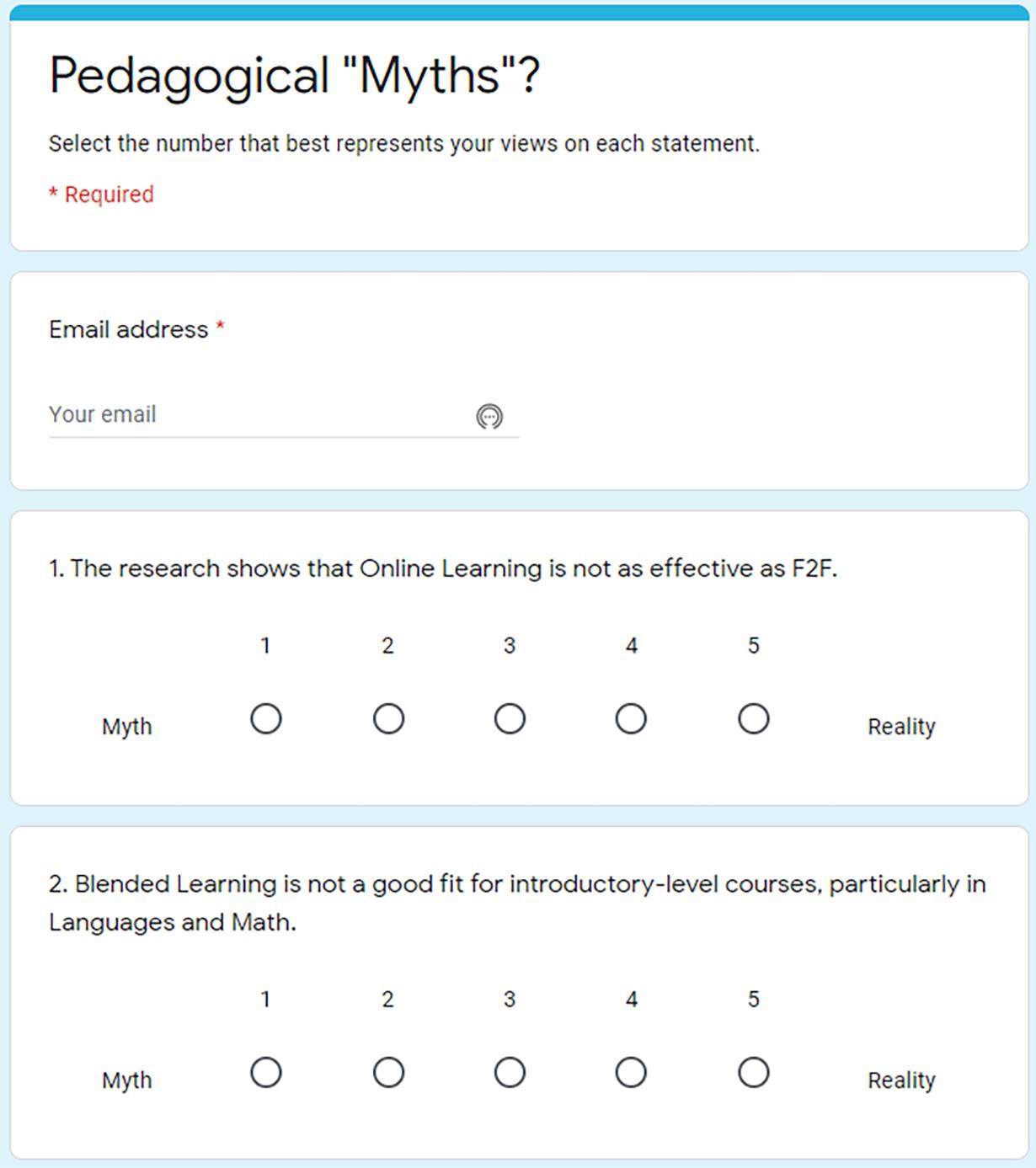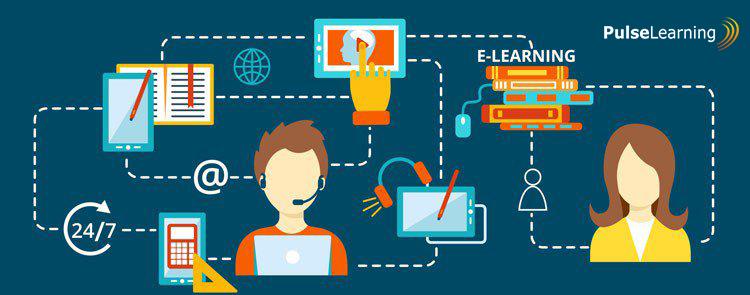
12 minute read
III. Common Misunderstandings
Many educators long for the day that we return to campus and life proceeds with a kind of “new normalcy” that the current online learning arrangement does not seem to satisfy. One wonders whether that return to campus will be accompanied by an enlightened understanding of student learning or whether the perceived limitations of online will be used as a “straw man” to argue for a return to prior programs and pedagogies. Are the intuitions of most educators based on the realities of learning research or are they influenced by an inertial mythology of the differences between F2F and online learning? Does the existence of that mythology inhibit teachers from extracting “lessons learned” from the online experience? We surveyed teachers to see where their beliefs about online and other progressive pedagogies fall compared with colleagues. Let’s look carefully at some of the misunderstandings highlighted by the reported variations in results.
1.
Advertisement
Segment of OESIS Online Survey
The research shows that online learning is not as effective as F2F — MISUNDERSTANDING — Hundreds of research studies have looked at online and F2F comparisons with varying results. The biggest drawback is the establishment of control groups since we rarely ask students to complete the same course twice
2. 3.
with differing delivery mechanisms. Most of the more recent studies conclude that there was no statistical difference between the assessment results from students that participated in both online and F2F courses. Furthermore, a third mixed delivery

option, blended learning, yielded better results than either F2F or online. Blended Learning is not a good fit for introductory level courses,
particularly in language and math courses — MISUNDERSTANDING — First, blended learning is a mix of F2F and online delivery designed to take advantage of the strengths of both. Many teachers have argued that blended learning may work well for older students in more advanced courses, but not for younger students and/ or introductory courses, where they argue face time is critical. Prior to the explosion of online multimedia voice and video, that argument may have contained some truth, but today there is little evidence that students always have to be under the supervision of the teacher in order to learn introductory curriculum. In addition, the station rotation model, in which students work independently for periods of time, is widely used in Pre-K through elementary grade levels. Thus, a blended model would certainly work in middle and high school. A number of independent schools have seen great success with the blended approach, and it has addressed a number of bottlenecks in school schedules and course enrollment fluctuations. Fewer class meetings means a more flexible schedule, better suited for the CBE, PBL, and SEL environment. Also, blended learning, like online learning, supports personalized learning plans very well. One school, experiencing significant declines in Latin enrollments, combined all Latin students in a blended environment so each student
in the “class” could progress from their current level of expertise at their own pace.
Online Learning was not designed for young children — Potentially a MISUNDERSTANDING — When online was reading-intensive, young children’s interactions with the online world were primarily through simple games and
dialog. Today, young kids have the benefit of a full set of media tools for simulation, cartoon explanations, video, and live conversations with teachers. Still, short attention spans and visual fatigue are important considerations when designing an online program for young children, and parents will almost certainly have to play a role in their children’s learning. One suggestion from an experienced educator was seven-minute segments of activity followed by seven-minute breaks, with longer breaks every 30 minutes. Another educator pointed out that failing to follow such a structure resulted in young students completing the work for the day in two hours or less, and parents asking the school for more work. Schools have responded by recommending the breaks and explaining to families that heavier workloads are a form of babysitting. In short, there are a variety of ways to engage young children in online learning as long as it is chunked in small morsels, parents oversee the work of their children, and expectations are appropriate for the age level. See Khan Academy Kids as an example.
4 abcMouse.com

4. Online delivery is a secondary or backup strategy to be used when
our schools are forced to close or operate during a pandemic — MISUNDERSTANDING — While the current scenario certainly influences the spread of this misunderstanding, stepping back for a moment will reveal evidence to the contrary. First, many independent schools are currently offering online courses to their students, primarily through consortia. For most of these schools, there is an implicit understanding that these credit-bearing courses are academically equivalent to any other course in the school catalog. Second, schools that are practicing blended learning are de facto endorsing the notion of online delivery of learning. What was different about the Spring 2020 scenario was its
5.
universality. All of school occurred online. What if there are other scenarios besides a pandemic that force your campus to close or evacuate, and what if you enroll students in other parts of the country or world who must use the online delivery platform to become part of the school, either through separate online courses or hybrid courses with a mix of F2F and online students? Futhermore, in the blended model, there is a significant online component. Would we argue that for some students or at certain times learning is less effective because of the

delivery format?
Many online initiatives have failed — likely a MISUNDERSTANDING — Unfortunately, the media would have us believe this since they cover big failures more than big successes. Many early initiatives failed because the infrastructure wasn’t as robust, and the audience was different; online was primarily targeted at continuing education. It wasn’t a delivery alternative, but a necessity. During the past 10 years, the infrastructure has improved significantly, and the scope of online audiences has expanded. Some observers have written that MOOCs failed, and that is because repackaged, recorded lectures are not going to capture the hearts and minds of busy post-college adults. Course quality should be designed for the audience and take advantage of the strengths of online learning. A forklift move of a course from the F2F classroom to an online platform is an expedient decision, and not a good long-term strategy. Consequently, as teachers and students better understand the strengths of online delivery, the quality of online learning will improve.
6. 7.
Online learning is generally lower quality learning than F2F — MISUNDERSTANDING and inconsistent with learning theory — The quality of any learning is measured by student assessment, both formative and summative. Delivery platforms do not define the success or failure of learning. Formative assessments work as well, if not better, in the online world because they can compile results for teachers instantaneously (an exit ticket, for example). Summative assessment in the online world will vary based on design. The traditional factual test/exam is always at risk in the online world because there are many sources for answers, despite the desire to “lock down” the desktop. If we were to design assessments that were aligned with the online delivery platform, they would work equally well in the F2F setting, but would be different than traditional classroom assessments. Certainly, the PBL and CBE assessment models, where students demonstrate their mastery of topics and competencies, will work well in any delivery setting. When we have more alignment of assessments that are delivery-neutral, we will be able to research
potential variability in outcomes.
F2F learning is inherently more equitable than online learning
— IMPLICITLY BIASED by experience; lacking data to draw reasonable conclusions — It’s important to distinguish between equity of infrastructure and home environment, and equity in learning. The latter is most closely tied to personalized learning and is delivery neutral. The goal of student equity is to meet students where they are, as a starting point, and allow them to proceed at their own pace with support through teacher intervention. The argument made by most supporters of this likely myth is that some students do not have access to online tools and therefore are at an inherent disadvantage. In public schools, that has turned out to be a big setback in the current environment to the point where a local TV news channel in Washington, DC, has carved out time in their broadcast day for schools to deliver assignments and content to their students. In the independent school world, we have at minimum, a responsibility to make sure that equity at the basic needs level is practiced. People who are paying for their education must be provided with the tools and access to make them successful. Once those tools are provided, a shift to PBL, SEL, and CBE options will create an equitable learning experience.
8.

Online learning causes screen-time fatigue, something we don’t
experience in the F2F world — INACCURATE and misdirected — First, online learning doesn’t cause screen-time fatigue; spending too much time in front of a screen does. Effective online learning design (primarily asynchronous) does not keep students in front of the screen all the time, particularly younger students. Second, fatigue can certainly be a factor in a F2F classroom as well. Last year, I observed a high school classroom of 12 students, in which four dozed throughout more than half of the class, and another four spent a good deal of time looking at websites that were unrelated to the subject-matter (shopping for shoes, ESPN, various actors). Learning fatigue is a result of lack of engagement and variety (or no sleep) and can be addressed with effective online learning design. Too much time on anything or boredom will lead to fatigue. See Brene Brown’s recent blog post regarding screen time fatigue and the call for everything in moderation:
And, for those of you asking students to get dressed and sit in front of the computer for 8-10 hours, as if they’re in class . . . I hate to have to tell you — that is NEVER going to happen. Neurologically — it’s screen time. Have you ever been in the same room with someone who has played Minecraft for four or five or six hours? Non-human.
9. PBL, despite its delivery platform neutrality, is an old pedagogy that
never gained much traction — MISUNDERSTOOD and INACCURATE — PBL might be old by contemporary standards, but that doesn’t mean outdated (the factory model is much older). Good ideas often take time to catch on. Regarding traction, PBL is growing more quickly worldwide more than any other pedagogy (not surprisingly, the U.S. is behind). The number of schools that use PBL exclusively is much smaller. As we have argued earlier, PBL is aligned with almost all of what we currently understand about effective learning, and while it may challenge the requirements of a traditional content-intensive curriculum, it does not undervalue the importance of content. Students who successfully complete PBL projects master the content to which they have been exposed and develop many more skills than students learning in a traditional scope and sequence curriculum.
The coverage model of teaching courses is really designed for the school and the teacher, not the student. By moving through course material at a pace defined by the length of the term, only a small segment of students in the class will be able to master that material. The rest of the students will have gaps that our Carnegieunit system has determined will be reflected by lower grades and movement to the next level with only partial understanding. We are asking students to construct a house frame with a hammer but no nails. It is an unfortunate view of our traditional courses, in contrast with the learning and equity benefits of PBL, a pedagogy whose time has come.

10. Teaching students SEL is the job of school counselors, psychologists,
11.
and the medical staff — OUTDATED AND UNREALISTIC — Before we understood the impact of social-emotional learning on student academic success, it was prudent to make this claim. Now that we understand the direct and consequential connection between the social-emotional state of students and the effectiveness of their learning, it is the job of every teacher to integrate SEL into their curriculum. PBL provides the easiest pathway for such integration because the set of SEL skills required are well-defined (collaboration, communication, empathy). If we are creating social-emotional obstacles for students as a result of course-related challenges or if we are failing to recognize student anxiety as an inhibitor to learning on any given day, we are not acting in the best interests of
our students.
CBE is beyond the capability of most schools to implement and
requires a challenging reorientation of school constituencies — MISUNDERSTANDING OF THE EDUCATIONAL CANON; anything worth doing is worth doing well — If your school is planning to embed CBE into the fabric of who you are, then it will be challenging to implement, meaning strong leadership required, lots of people involved, and much time invested. There are strategies and plans available that make the process more transparent and accessible, and some schools are well on their way to full implementation. Alternatively, if you view CBE as a marketing promotion (define portrait of a graduate for your website and identify competencies that are disconnected to coursework as your end point), then it will not be difficult to implement. Reorienting your faculty, students, parents, alumni, and Board is not as challenging if one approaches the pivot from a self-reflective framework. Ask yourself some key questions (many schools are) such as whether the current system of grading is equitable and fair to all students in all courses for starters. As you explore the honest answers to that question, you will construct the argument for CBE in a way that will be difficult to challenge except on the grounds that it is a risky change, threatening a system that worked successfully for many years (reflecting Robert Evans’ sense of loss as part of school change). Of course, remaining status quo is also risky because some of the schools with which you compete may not remain status quo and you could be viewed as the outlier or be unprepared for sudden enrollment shifts as a result of existential factors. While not every school can implement CBE today, every school can be planning to move forward with CBE. The weight of the answers to the big questions you pose will determine how vigorously your school pursues the prize of personalized and effective student learning in a vibrant community, what you sell.





